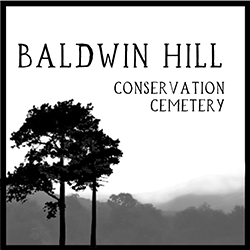
Understanding Conservation Burial

The Burial Process
The sequence and specifications.
Burial in the upper soil zones.
To encourage a more rapid and complete decomposition, burial at Baldwin Hill Cemetery will take place in the more biologically active soil zones—higher than the depth of conventional vaulted burials, which tend to be six or so feet deep. Graves at Baldwin Hill Cemetery are dug approximately 3 feet deep measured from the original grade to the bottom of the hole.
By placing the body in a biodegradable container in these upper soil horizons, decomposition via living organisms in the presence of oxygen takes place quite successfully.
For more information on the science of decomposition as it relates to natural burial, see The Science Behind Green Burial from the Green Burial Council.
Full Body Burial.
Graves for full-body burial are typically dug with an excavator by the burial contractor. The top layer of organic material is removed from the excavation site and placed aside to later cover the interment.
Once the body has been placed in the grave, either in a shroud, casket, or some other biodegradable container, the soil is replaced and lightly tamped by the burial contractor. The site is then covered with organic material for erosion control and aesthetics. Funeral participants may wish to leave cut flowers or other biodegradable decoration. The memorial stone and plantings are typically placed at a later date.
Note: Vaults and similar outer interment containers are inconsistent with green burial and are not permitted. In the event that an outer interment container (such as a vault) is placed or constructed within the cemetery, the Baldwin Hill Cemetery reserves the right to remove said structure at the expense of the offender.
Cremains.
Procedures for the burial of cremains are essentially the same, but because the hole is much smaller, hand tool excavation is possible. We recommend that cremains be placed without an urn directly in the grave and mixed with a mass of loosened native soil. This helps to dilute the alkalinity and high concentration of salts/minerals found in cremains. It has been suggested that such mixing may allow the nutrients to become more available to trees and plants and reduce the ‘burning’ effects to nearby plant growth. Burying of an urn is therefore not encouraged but is allowed if desired.
Holes must be large enough to fit the cremains/urn with approximately 6 inches of soil cover.
For burial of cremains, family’s have the option to work with the burial contractor or to dig the hole themselves with hand tools under supervision of cemetery staff. There is still a cost associated with cemetery staff supervision. See Other Costs for more information.
Cemetery density.
The density of plots will vary in the Cemetery due to obstacles such as trees, tree roots, boulders, burial equipment travel corridors, and the universally accessible trail. Density is therefore not defined at a sub-acre level, other than to maintain clearances around obstacles and other plots. Overall density will be maintained at or below the Green Burial Council standard for a conservation burial ground: a maximum density of 400 burials per acre and an average density of 300 burials per acre. We estimate that density will be even less than 300 per-acre. By comparison, many conventional cemeteries have densities of 1,000+ per acre.
Participation in the Burial Process.
In accordance with Green Burial Council standards, family and friends of the deceased are allowed to participate in the burial process. For practical and safety reasons, participation is limited to placing limited quantities of soil back into the grave during closing, or other ceremonial procedures. Graves are prepared by the burial contractor, who has responsibility for the final state of the interment. A shovel or shovels will be available for loved ones to place soil in the grave. Additional burial contractor fees may apply depending on the level of participation.
